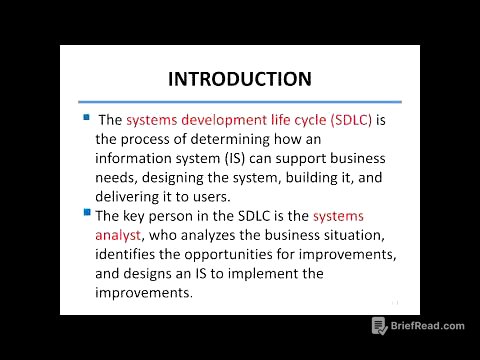TLDR;
This video explores the methods hackers use to crack software, focusing on the activation process, reverse engineering, key generation, and manipulating jump conditions. It also discusses how developers can protect their software through secure coding practices, strong server-side validation, and obfuscation techniques. The key takeaway is that while no software is uncrackable, making it difficult significantly deters hackers.
- Hackers exploit weaknesses in software design through reverse engineering, key generation, and manipulating jump conditions.
- Developers can protect their software with secure coding, thorough testing, and strong activation mechanisms.
- The goal is to make software cracking difficult and time-consuming, discouraging most hackers.
Intro [0:00]
The video introduces the two sides involved in software: the creators who develop the software and the hackers who attempt to bypass its security. It promises to explore the techniques hackers use to crack software, providing viewers with an understanding of these methods and highlighting the importance of developers staying ahead to protect their creations.
The Two Sides: Creators and Hackers [0:03]
The discussion centres on the contrasting roles of software creators and hackers. Creators invest significant time and effort into developing software, while hackers dedicate themselves to finding ways to circumvent its security measures. The video aims to explore the techniques employed by hackers to crack software.
How Hackers Crack Software [0:12]
The video will explain the step-by-step techniques hackers use to crack software. By understanding these methods, viewers will appreciate the importance of developers staying vigilant and proactive in safeguarding their software.
The Activation Process: Online, Offline, and Pre-activated [0:27]
The activation process is the initial security measure for premium software, ensuring only legitimate users can access all features. The security level depends on the activation method used. There are three main types of activation: online, offline, and pre-activated. Online activation uses server-side code to validate keys, while offline activation uses embedded code within the software. Pre-activated files have already bypassed or removed the activation process. Hackers target these processes to find vulnerabilities. Weak offline verification mechanisms make software an easy target for reverse engineering.
Weak Verification and Loopholes [1:03]
Hackers specifically target the activation processes to identify and exploit any existing loopholes. If a software's offline verification mechanism is weak or poorly implemented, it becomes particularly vulnerable and an easy target for reverse engineering attempts.
Why Full Details Can't Be Shared on YouTube [1:19]
The presenter explains that detailed demonstrations of bypassing online activations or reverse engineering software cannot be shown on YouTube due to content restrictions. However, more in-depth guides are available in the presenter's academy. A discount code is offered for a limited time.
Reverse Engineering: The Foundation of Cracking [2:02]
Reverse engineering is a core technique in software cracking, involving disassembling and analysing a program's code to understand its functionality and identify activation mechanisms. Hackers aim to understand how the software works and how to bypass its security measures. This process involves taking apart the software to see how each piece fits together, then modifying it to simplify the activation process.
Tools and Techniques of Reverse Engineering [2:26]
Hackers use debuggers and disassemblers to break down the program's code. Once the activation code is identified, it is tweaked and recompiled to create a crack. This might involve disabling activation checks, tricking the program into thinking it has been properly activated. The process is simpler if there are no post-activation checks.
Online Activation Challenges [2:50]
Online activation is more challenging to bypass due to server-side keys and external validation. However, vulnerabilities such as poorly implemented communication between the software and the server can be exploited. Hackers might intercept and analyse data sent to the server or manipulate the software to accept invalid keys. Software with strong server-side validation and encrypted communication is more resistant to these attacks, but no system is completely foolproof.
Key Generation: Cracking the Algorithm [3:27]
Key generation involves reverse-engineering the algorithm used to create unique software keys. Hackers aim to understand how these keys are generated so they can produce their own valid keys without purchasing the software. For example, if a program generates a key based on an email address, the hacker studies the pattern behind the digits to replicate the algorithm and create a key generator.
Manipulating Jump Conditions [3:56]
Manipulating jump conditions is another method where hackers modify conditional checks in the software that verify license validity. By locating these checks through reverse engineering, they alter the code to "jump" directly to the part where premium features are unlocked, bypassing the activation process entirely.
Protecting Software from Cracking
[262] Now that we’ve discussed how hackers crack software, let’s look at how developers can protect it. First and foremost, secure coding practices are essential. Many vulnerabilities stem from poorly written or unoptimized code. Regularly reviewing your code and conducting thorough security testing can uncover potential weak spots before hackers do. For online activation, implementing strong server-side validation and encrypting communication between the software and the server can add an extra layer of protection. Additionally, using obfuscation techniques to make your code harder to read and reverse-engineer can slow down potential attackers. Keep in mind that no software is completely uncrackable, but a well-secured program makes the process far more difficult and time-consuming, discouraging most hackers from even trying. [299] By now, you should have a solid understanding of how hackers approach software cracking and the tools and techniques they use to bypass activation. Whether it’s reverse engineering, key generation, or jumping conditions, each method exploits weaknesses in the software’s design. As developers, the goal isn’t to make your software impossible to crack—that’s unrealistic—but to make it so difficult that hackers move on to an easier target. With secure coding, thorough testing, and strong activation mechanisms, you can protect your software and your hard work.









